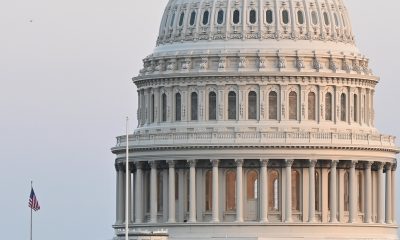Opinions
Is the Washington Post editorial board asleep?
Is Jeff Bezos controlling them?

I submitted the column below to the Washington Post as an oped with the above headline, having no real expectations it would be published. They often publish my letters, but never when I criticize them directly. Imagine my surprise when I received an email after five days from Ryan Vogt, in the opinions section of the Post, sharing a version of the oped they had shortened to a 228-word letter, asking if I was OK with that version and saying if I was, they would consider publishing it. I wondered if he did the editing. I gave him an immediate OK to publish it. Then having heard nothing from him for a few days, I contacted him and was told “unfortunately, it is falling out of the mix of letters to be published.” My comment back to him was “no surprise.’
Here is the oped as I submitted it to the Post:
When the publisher of The New York Times, A.G. Sulzberger, is given space in the Washington Post for his oped, ‘How the quiet war against press freedom could come to America’ on the threat to the free press if Trump is elected, it’s time for the free press to speak out. The Washington Post editorial board seems to either be asleep, or willing to let MAGA Republicans win. One would think their slogan ‘Democracy dies in darkness’ would compel them to speak out.
The Post is the major newspaper for the DMV area, and they have yet to make an editorial endorsement in the presidential race. They didn’t endorse Senator Tim Kaine (D-Va.), running against a MAGA Republican for reelection, until three days after early voting began in Virginia. They have yet to endorse any congressional candidates in Virginia when we know there are a host of MAGA Republicans running who have endorsed Donald Trump and his platform.
I understand newspapers report the news, but then reporting, and editorial content, are two different things and should be separate. Now it would be nice if editors suggested to their reporters, like it seemed they did when writing about Biden and appending his age to every mention of him, that when reporting on Trump they would append the facts he is now the oldest man to ever run for president on a major party ticket, is a convicted felon, and been held liable for sexual assault. All verifiable facts.
One has to question what is holding the Post back from issuing a presidential endorsement. Are they actually thinking of endorsing a man who their paper wrote tried to stage a coup on January 6, 2021. A candidate who has said he wants to be a dictator on his first day in office, and use federal agencies to get back at his enemies. If they really care about democracy, and freedom of the press, they should be editorializing for Kamala Harris every day in an effort to defeat Trump and his MAGA cult. They should be endorsing against any candidate who supports Trump, and should have done it before voting began.
Either the editorial board is afraid to speak out, asleep at the switch, or being controlled by the paper’s owner, Jeff Bezos, who might have asked them to hold up endorsements. Are they trying to play both sides in this election in an effort to not lose subscribers? Any of those possibilities is scary, and incredibly sad, for what was once a great major newspaper. A paper owned by the courageous Katherine Graham, who was willing to stand up to a president, no matter the cost to her, or her paper.
Does the Post’s editorial board lacking diversity have anything to do with holding up endorsements? Why are they seemingly cowering in a corner without any backbone, or willingness to stand up for a free press, and democracy. Is the fear of losing subscribers so paramount the Washington Post continues to publish MAGA Republican opinion columns, and yet won’t endorse? What principles does their editorial board believe in? What do they think will happen if the writers of Project 2025, Trump’s friends, end up in the White House, and have positions throughout the administration? What do they think, if they are thinking at all, will happen when the federal Department of Education, including its Civil Rights division, is closed? If the Federal Deposit Insurance Corp. (FDIC) is closed, and people no longer have insurance when banks go under, do they care? From the editorial board’s lack of action, it would seem they either don’t care, are in favor of those things, or don’t understand the ramification of those possibilities.
The Washington Post, a once respected paper, owned by Katherine Graham who was willing to stand up for democracy, is now just a ghost of what it once was. If Trump wins because they lack the courage to speak out, they could become totally irrelevant. This is not a time for looking the other way, or thinking they have to be fair to all sides, when one side will destroy what they claim to stand for, a strong democracy and a free press. As early voting continues in Virginia, with no endorsements form the Post, and ballots are sent out in D.C. and Maryland, shortly what the Post editorial board does won’t matter. They will just be another paper, with a big megaphone, they refused to use.
Peter Rosenstein is a longtime LGBTQ rights and Democratic Party activist.
Opinions
Democratic Socialism won’t win the whole country
We must work toward a blowout on Nov. 3, 2026

It was a great win for Zohran Mamdani, and his voters, in New York City. His message of hope and change clearly resonated with younger generations, and that is exciting. But while Democratic Socialism, and Eugene Debs, may be the future of New York City, they won’t win the country. Mamdani is a young, smart, charismatic, politician. He is a great speaker, and in his campaign made many promises. Keeping those promises won’t be easy, but whether he can keep them will be what he is judged on. I wish him much success as what he envisions is important. But as Democrats, we need to understand, his brand is not going to be what wins it for Democrats in 2026. It will not win the swing Districts we need. We know that by looking at history.
I am a proud New Yorker by birth. When traveling the nation as a teenager with the Boy Scouts, going by bus across the country to the 25th Jamboree in Colorado Springs, I understood we in New York were the different ones, not the rest of the nation. I understood at an early age how important it is to respect those differences and they still exist today. If we are to move the nation forward, we have to do it with respect, and together.
I looked at how Mikie Sherrill won the governorship in New Jersey, and Abigail Spanberger won in Virginia. Their strong messages, more in line with the majority of voters in the nation who see themselves as moderates, are likely to resonate with Democratic voters across the swing congressional districts Democrats need to win in 2026, if they are to take back the House. Based on exit polling their messages also invigorated many young voters. We will need everyone to take back Congress and doing so is a must if we are to save our country from the felon in the White House.
There are countless reasons to stop Trump. He wants to be a king, and has said so. He acts like a despot declaring war on foreign countries without congressional consent, and even declaring war on American cities. He doesn’t understand the United States is a nation of immigrants and without them we are in trouble. I guess the only immigrants he found of value were two of his wives, and he even screwed around on them. He uses ICE as if it were his personal Gestapo. He sends National Guard troops across the nation and into D.C. where some picked up trash in the parks and spread mulch. Not what they signed up for, and a total waste of taxpayer’s money. He threatens the world’s nations, allies, and foes alike, with tariffs that end up being a heavy tax on the American taxpayer. He pretends to negotiate deals, like one with China, not even getting us back to the positive relationship we had with them when Biden was president. Trump screws up everything he touches. He plays footsie with Putin. He refuses to actively support the brave people of Ukraine whose war against Russia is in essence, a proxy war with the West. He gives tax breaks to the rich, and is willing to close the government instead of ensuring everyone has affordable healthcare. He threatens the poor with starvation, and screws with the nation’s healthcare, destroying the CDC, and the National Institutes of Health (NIH), the world’s premier medical research institute. He threatens law firms, universities, and the media, holding them hostage for money. He uses the Department of Justice as his personal law firm to get revenge on anyone he thinks did him wrong. He fires thousands of government workers, and when his incompetent appointments screw up, has to rehire many. He is a grifter, exchanging favors for money for himself, with countries around the world. A plane from Qatar, and billions for his crypto company.
What Americans are seeing as the result of his incompetence, are prices for food, rent, and education, all going up. Farmers are suffering. All this is what Democrats will campaign on across the nation.
But they must also campaign on what they will do to make things better. They must talk to their constituents in each District, and determine the focus of their campaigns. What issues to campaign on. Those campaigns could look different in each District. That is how Democrats will win. That is how Democrats won last Tuesday, and that great start will lead to a huge Blue Blowout, on Tuesday, Nov. 3, 2026.
Peter Rosenstein is a longtime LGBTQ rights and Democratic Party activist.

Voters handed Democrats a sweeping victory across the country in the Nov. 4 elections. Donald Trump’s Republicans paid dearly for their inability to restrain or conceal their recklessness and cruelty.
In response to being roundly repudiated at the polls, Trump boasted, lied, made insults and threats. Mind you, this is a man who confuses dementia screening with an IQ test. And he once proposed nuking hurricanes.
Trump’s howlers, including the claim that every election he loses is rigged, are persuading fewer and fewer people.
You would never know, on this bright autumn morning, that a pitched battle is underway for the soul of America. As I sip my coffee in the McDonald’s, a little girl walking by with her daddy climbs into the chair at the next table. She is holding a TV remote control for some reason. I ask her not to point it at me because I don’t want to be switched off.
To be honest, there are people I wouldn’t mind switching off, at least from my newsfeed. For example, I saw this headline concerning an obnoxious congresswoman: “Nancy Mace escalates fallout from foul-mouthed airport meltdown with legal threats after criticism from fellow Republicans.”
Is it possible that Rep. Mace, who is running for governor of South Carolina and has been calling trans people crazy, is so starved of attention that she has to scream at officers in airports and threaten lawsuits? I stress that I’m just a humble commentator and do not mean to provoke her.
I can’t help recalling that the phrase “Trump Derangement Syndrome” arose not as a reference to Trump’s own mental health issues but as an effort to deflect such concerns onto his critics. Lately, however, we who wish to be rid of the Worst President Ever have gone from being mad to being domestic terrorists in the eyes of Trump diehards. We are also called insurrectionists, despite never having incited a riot at the U.S. Capitol, because the leading insurrectionist—who deems himself above the law—is considering invoking the Insurrection Act to consolidate dictatorial power.
Are you keeping up with all this? I know it sounds crazy. You never know what jarring images you’ll stumble upon. On election night I switched to CNN, saw former Chicago mayor Rahm Emanuel, and immediately reached for my remote control like that little girl in the McDonald’s. And Rahm is a Democrat!
New York City Mayor-elect Zohran Mamdani is an immigrant who grew up in New York. I am a native Washingtonian who grew up in Maryland’s 8th congressional district, currently represented by constitutional scholar Jamie Raskin. Raskin has happily dubbed Mamdani an FDR Democrat.
You might think comparing a gifted young politician to Franklin Delano Roosevelt would not scandalize anyone at this point; but you would be wrong. Lots of Republicans still decry FDR as a socialist. These are the same people set on robbing millions of their healthcare and nutritional assistance.
Trump, who hosted a Great Gatsby-themed party at Mar-a-Lago hours before millions of Americans lost their SNAP benefits, touted the Roaring Twenties as a high point in America’s past. I don’t want to burst his bubble, so please don’t tell him that the 1920s ended in a stock market crash that ushered in the Great Depression. God forbid his tariffs lead to another crash. He would likely blame it on Mamdani, rebrand it a communist Islamic jihad, and deport it to Eswatini.
Democrats like me support capitalism, but with guardrails. By contrast, the oligarchs—epitomized by Elon Musk with his recently approved $1 trillion pay package—love to blame others for the harm they cause, while making off with the moolah. Do not fall for it.
I am rooting for Mamdani, who wants working people to be able to afford to live in New York. He includes trans people in his vision. His victory speech was a far cry from the Islamophobic caricature painted by his detractors, who range from right-wing pundits to Andrew Cuomo.
Based on the smears, you might expect the mayor-elect to rush to Washington to demolish part of the White House, had the president not beaten him to it. Yet in the wake of Mamdani’s historic victory, billionaires who fought tooth and nail to defeat him bent the knee and pledged their help.
Mamdani is not the model for all Democrats; he reflects but one part of our diverse coalition. The midterm elections are a year away. All our voices and votes will be needed to defeat the authoritarians.
Copyright © 2025 by Richard J. Rosendall. All rights reserved.
Richard Rosendall is a writer and activist who can be reached at [email protected].

Blade contributor Peter Rosenstein is crossing the Atlantic on the Celebrity ASCENT. He filed these dispatches from his journey.
Blog # 1- 2025 Celebrity ASCENT transatlantic cruise
Spent two great days in Rome. I don’t sleep on planes so the first morning was kind of a blur. I had arranged for a taxi from the airport, which worked well, and arrived at my hotel, the Nuova Nord, near the train station, about 10:00am. Check in time is officially 4:00pm but I lucked out, and got into my room by 10:30. This just added to my feeling good about the hotel, along with the $115 a night cost, including breakfast. So put my suitcase in the room and headed out to walk around Rome. My first stop as usual in Rome was the Trevi Fountain, which I love. Once there, did what I always do to get a great picture. Headed across the street from the fountain to the second floor of Benetton. They still have one window that remains clear, and you get the best picture above the crowds. Then I kept walking past the Coliseum, and eventually over toward the Vatican. I had made plans in advance to have dinner with Samantha Basar the new staff addition to My Lux Cruise travel agents, and Jill Lotenberg. Jill is an amazing professional photographer, and documents the cruises we go on. We had a nice early relaxed dinner, and after walking it off, I was back at my hotel before 8:00pm for a good night’s sleep.
The next morning met a D.C. friend, John, who just happened to be in Rome visiting his parents. John’s mom is Italian, and I was surprised to find he speaks the language fluently. We went for coffee at 11:00am at a café he likes near the Pantheon. He swore by their coffee and pastry, and he was right, it was really good. Then we spent a few hours walking the city, and ended up at the Basilica di Santa Maria Maggiore to see the tomb of Pope Francis. There was a long line but it moved really fast, and the tomb is like the former Pope, very simple, but truly impressive. After that John found a scooter to ride back to meet his parents. I think it took a lot of guts to ride a scooter into Rome traffic. I spent a little more time walking around. It was going to be an early night with some pizza for dinner.
The next morning, I headed over to the UNA hotel, just a couple of blocks away, to meet the bus arranged to take my group to Civitavecchia, the port about an hour out of Rome, where we boarded the Celebrity ASCENT, our home for the next thirteen days. That all went really smoothly, and I was onboard, in my stateroom, before 11:00 AM. Then it was meeting my butler, yes, I have one, as does everyone in the Retreat, and also met my very charming room attendant, who had made sure my bedding was all hypoallergenic. Then walked around the ship to see if there were any changes since my cruise last year. There didn’t seem to be any. Then at 4:30 headed to the sail-away party Dustin and Scott, my favorite travel agents, had prepared for our group in their suite, the Iconic Suite, to meet old and new friends. We left port a little late as there apparently was a medical emergency even before we left port, and an ambulance was called to take someone off the ship. Turned out it was a member of our group, but thankfully he is ok. When we finally set sail, we all headed to the first of the nightly, listed in the daily newsletter, as the LGBTQIA+ get togethers, in the Eden lounge. There were more people there than we expected, and it was nice to meet more new cruisers from both the States and Europe. Then it was off to my first dinner onboard, at the Rooftop grill, with Michael Magee and his friends, most of them new to me. It was a nice evening, and the baked cookie with vanilla ice cream, the main reason to eat at that restaurant, didn’t disappoint. Then it was back to my cabin for some sleep as I had an early tour booked the next morning in Cagliari, Sardinia.
Day 2 began in an interesting way. Hope it doesn’t portend anything, but early morning the Captain announced we would be getting to Cagliari about 30 minutes late as there was another medical emergency on the ship, and he had to divert closer to shore to let the Italian Coast Guard take the person off the ship. Hopefully he/she will be ok.
We finally docked in Cagliari, and I headed to meet the bus for my tour. It was a four-hour City Highlights tour. We drove around the Island and then had some time to walk the city center. It included stops at the museum, and we saw some beautiful old churches. It is a beautiful city. The tour guide was a very nice woman but talked incessantly, never feeling the need to take a breath, lol, and her voice was a little hard to take in our ears from the little gizmos we each had. I kidded about it with two nice guys I met on the tour from Vancouver, Canada, who agreed with me. Then it was back to the ship and some relaxing time on the Retreat sundeck, a cappuccino in the retreat lounge, and then the second LGBTQIA+ happy hour. Then dinner with Scott, Dustin, and Rick, in Luminae restaurant, the Retreat restaurant. Not an auspicious start for their menu, as the steak was close to inedible. But the charming staff, and chocolate desert, made up for that. Then it was off to the day after Halloween party the ship threw, and saw some incredible costumes. Then to bed after a great first full day, day two according to Celebrity, of the cruise.
Blog # 2- 2025 Celebrity ASCENT transatlantic cruise
Day 3 was a sea day. We were heading from Cagliari to Gibraltar. It is days like this why I go on my transatlantic cruises. I love being on the water. Spent some time in the morning writing and then headed to the gym for the first time. I hope to go there for at least an hour each day. A half hour on the lifecycle and then another thirty minutes with some weights and machines. It is great to sit on the lifecycle looking out at the ocean, instead of the wall I look at when using it at my home gym. I then headed to the Retreat lounge for my cappuccino and then up to the sun deck. It was very windy but I found a place out of the wind to sit and read. Then back to the Retreat lounge where I am having this running argument with the retreat managers, trying to get them to help me with my WIFI. Seems this year the powers that be don’t want to give me access to my phone and the computer, at the same time, without an extra charge. Just typical of what we are seeing on the cruise by Celebrity, think it may also be on other lines, of the nickel-and-diming of passengers. Other than that, things have been good, LOL. Then headed down to deck 4 and Café al Bacio, where I enjoy going for a light lunch.
They have these great little sandwiches, and some more good cappuccino. By this time, I am getting the decaffeinated kind. I met Jill Lotenberg there, our group photographer. She is a professional photographer who is related to Scott, my travel agent, and joins us on the cruises to document them. She is so fun to chat with. Also there, sitting somewhere else, was Samantha. The day went by lazily and then it was time for the LGBTQIA happy hour. There I met Michael Magee, and some other friends, and we decided to do Luminae for dinner, and the late show in the theater. It was Bridges. I had seen it before on a previous cruise, and it was just as great. Incredible talent on the ship. Before the show the Captains, yes there are two, and they are brothers. Celebrity assigned them both to the ASCENT as a PR gimmick when the ship was launched. They just happened to be together on this cruise heading back to the states. They spoke to the audience, and could make good money as a comedy act if they get tired of being captains. They are both charming and funny. After the show I walked around the ship for a bit, heading to the Martini bar just to look around and then it was off to my stateroom for a good night’s sleep.
Day 4 dawned nice and as usual I was up early with coffee delivered to the room. We were going to be docking in Gibraltar by 9:00am. I had a decision to make as to whether I would head into town after we docked, or just stay on the ship. Since I have been to Gibraltar a few times before, enjoying the monkeys there, I decided to stay on the ship. It’s always nice when the ship empties out. After a couple of hours of writing I headed to the gym and it was totally empty. So, no wait for a lifecycle or any other equipment today. Then it was off to the Retreat lounge and my cappuccino. The weather was great so headed to deck 17, the upper deck of the Retreat sun deck, found a nice lounge chair, and kicked back with my kindle and relaxed for a couple of hours. Then back to the stateroom to write for a bit, and get ready for the happy hour. Scott and Dustin had arranged for us to get early access to The Club to see the early show there, Smoke and Ivories. Again, have seen it before, but it is great and will see it again later in the cruise. I sat next to a gentleman who was saving two seats for friends. After a bit I began chatting with him and found out his son was in the show. His son is the dance captain, and an amazing tap dancer. His name is Britton, and I hope to interview him later during the cruise. He is only twenty-one and has been dancing professionally for three years. He was just given another year contract with Celebrity so will be on its newest ship, the XCEL, when I am on it for my 2026 transatlantic cruise. After the show a few of us headed to Luminae for dinner. Then there was a Pride Party in the Eden lounge to end the day on a great note. Now I could look forward to the next six days at sea as we head to Bermuda.
Blog #3 2025 Celebrity ASCENT transatlantic cruise
Day 5 dawned sunny but windy and the ship was rocking a little. I am lucky that it doesn’t really bother me too much at this time. Hoping it doesn’t get much worse. But again, not a day to sit on the sundeck. So, my usual coffee and breakfast delivered to the room, and a few hours of writing. Today I was drafting the column I would submit to the Blade tomorrow morning, after I saw the results of the election. Tuesday was going to be an important election in a number of states including Governor’s races in Virginia and New Jersey, the vote on proposition 50 in California, votes on Supreme Court Justices in Pennsylvania, the Mayor’s race in New York, and some statewide races in Georgia. My draft took the position that Democrats would win them all, might as well be positive. Then I headed to the gym for my hour of penance for all that I am eating. After that I got in touch with Cheryl and Jeff, childhood friends, who I knew would be on this cruise. We met at 1:00pm at the buffet for lunch and sat and talked until 4:00, it was great. Hope to get together with them again for dinner during the cruise. After that it was time to head back to the stateroom, shower and get ready for happy hour. We hung out there longer because Rick told us there was an entertainer named Tom who would be playing at 7:00pm. Turned out he had the wrong Tom. So, a group of us headed to dinner at Raw on Five, the sushi bar. Always good to eat there before too late in the cruise for the fresher fish. The company was great, but unfortunately couldn’t say the same for the food which I thought was not as good as on past cruises. After dinner I headed back to the stateroom and prepared to be up late waiting for election results. We are now four hours ahead of D.C. time, we have been setting our clocks back an hour a night on the ship for the past two days. So, Virginia polls closed at 7:00pm and I could start seeing results sometime after 11:00. They were coming in fast after that and all being great. So, my draft was right on target. I finally turned off the light at about 2:00am. Day 6 dawned rockier than yesterday. I was up early and finalizing my column to send to Kevin Naff at the Blade for Friday’s issue. It felt good to be sending such a positive column to him as Democrats had won big in all the key elections. I thought of last year when I was on a cruise when the felon won the White House and how depressed I was. After sending the column I headed to the gym. I had booked a behind the scenes tour of the theater and that was fun. I met Britton and his dad there. Britton had brought his dad for the tour and told me he would be dancing on the main stage on the XCEL. From there headed to Café al Bacio for a light lunch and then tired from lack of sleep last night, just went back to the stateroom and relaxed all afternoon until it was time for happy hour. Britton reminded me he and the Eden production cast would be performing in the Eden lounge this evening in the show, Wonder at Eden: Allure. I was hoping the ship wouldn’t be rocking too much for the show to go on. I actually felt sick at dinner, but think it was from something I ate at. I went back to the stateroom for an your but then felt better and headed to the show in Eden. It was great. It revolved around an artist who did a painting during the show with the cast at times holding his canvas. His name is Paris and he is amazing. I hope to chat with him more in the coming days. Then it was back to the stateroom and a good night’s sleep.
Day 7 dawned windy but warm. It was going to be a really lazy sea day. My favorite kind of day. Coffee delivered to the room, then the gym, then cappuccino in the retreat lounge. I headed to the sundeck but it was a little to windy to stay long. So some more writing, finally getting a start on my next book. I was working on the introduction to what the draft title is, From Camelot to Fascism in 65 short years. I then drafted a column on Jill Lotenberg our group photographer, but who is so much more than that. At 4:00pm headed to the iconic suite for Scott and Dustin’s second party of the cruise. This one was even larger as they invited people beyond our group and it was really nice. After that my plans for the evening included meeting Denis and Jonathan to head to the early show at the theater. It was Karen Grainger who is a great singer and is able to assume the voices of so many other singers like Cher and Streisand. Then it was of to Eden for a wonderful dinner. Celebrity will do away with this restaurant on the new XCEL.
That is sad as many think it is actually the best restaurant on the ship. After that it was off to sleep. We weren’t going to be setting our clocks back an hour as we had the past few nights.
Blog #4 2025 Celebrity ASCENT transatlantic cruise
Day 8 dawned grey and very rocky. The room was making all kinds of noises. But life on the ship remains the same for me, at least for my morning routine of having coffee delivered to the room, and then sitting down to write. I felt like I may be getting the beginning of a slight cold so would wait awhile till I decided if I could skip the gym for the day. No rush, as there was nothing else on the agenda.
In general, the sea days for me, as they say, are rinse-and-repeat. Turned out I did go to the gym, and then headed to the 2:30 show in the theater which was take two on Karen Grainger. She really is quite good and this afternoon she did her impressions of a new group of singers. As she says, she is an impressionist, not an impersonator. I think the show could be improved if she had pictures of the women in whose voice she is singing on the big screen behind her. There were clearly some in the audience who weren’t quite sure, especially of the women whose voices are not as distinctive. Now there was no mistaking when she sang in the voice of Cher, Streisand, or Janice Joplin. Again, she is really good. One of the members of our group, Michael Magee, had planned a caftan bar crawl. Dress up in a caftan, and stop at a series of the bars on board, and drink at each. I did pass on that, not really a costume person, or a big drinker, but did meet up with them at the LGBTQ happy hour and they looked great, and happy after all the booze. Then it was dinner at Luminae, and for me, an early night. On my way back to my cabin I bumped into Paris, the artist from the show at Eden the night before, and we reconfirmed we would get together with in the next couple of days for coffee. The daily newsletter on my bed when I got back to my cabin confirmed we gained another hour tonight so by the morning we would only be two hours ahead of the East Coast.
Day 9 dawned a little cloudy but a little less rocky. I was able to spend some time on the Retreat sundeck in the afternoon and had lunch there. Based on the daily newsletter there were two events I wanted to go to during the day. I first went to the gym to sit on the lifecycle, actually peddling while sitting there. Then I went to the afternoon show in The Club, A Tribute to Adele, by Molly Kane. She is great. Molly is part of the cast in the main theater, but based on this show she should be a headliner all on her own. Darren, the Cruise Director, gave her this opportunity and it was the smart thing to do. He is clearly a good judge of talent. Then at 5:00 I headed back to The Club for a Senior Officer Party, for Elite status guests. I have that status based on how many cruises I have been on. It doesn’t get me much, but the most important benefit is free laundry. From there it was off to the LGBTQ happy hour in the Eden lounge and then dinner in Luminae. After dinner most of my dinner companions headed to their cabins, but I went back to the Eden lounge for the 10:15 show, Wonder at Eden: Shimmerbox, with the Eden show cast. It was really good, and all the dancers, including dance captain, Britton, are great. There was a funny scene there with a woman who has her dog with her, saving seats and pretending the people were just in the bathroom. Well after an hour I spoke to her and she wasn’t happy I said something about not being able to reserve seats for that long. Then another woman went and removed her bag and sat down and got an ovation from a big part of the crowd. After the show it was back to my cabin. Still fairly early as we turned our clocks back another hour this evening. So now when I wake up will only be one hour ahead of D.C. time. Tomorrow is another sea day, and then Monday, we reach Bermuda.
-

 U.S. Supreme Court5 days ago
U.S. Supreme Court5 days agoSupreme Court rejects Kim Davis’s effort to overturn landmark marriage ruling
-

 District of Columbia5 days ago
District of Columbia5 days agoCapital Pride files anti-stalking complaint against local LGBTQ activist
-

 Politics2 days ago
Politics2 days agoPro-trans candidates triumph despite millions in transphobic ads
-

 Dining4 days ago
Dining4 days agoSpark Social House to start serving alcohol

















